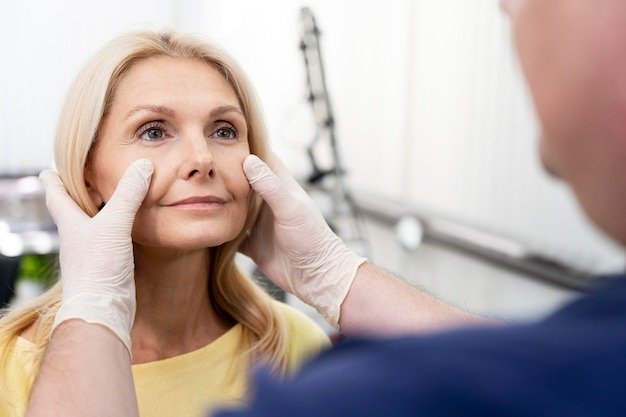Hooded eyes can alter your appearance, frequently making you appear worn out, elderly, or exhausted when that isn’t the case. Many people struggle constantly with their appearance because of the extra skin that hangs over their eyelids. Thankfully, blepharoplasty, commonly referred to as eyelid surgery, provides a solution that can help with functional problems like vision problems in addition to improving the appearance of your eyes. Hooded eye surgery has become increasingly popular, particularly among people who want to look younger and more refreshed. Here is all the information you require regarding this process and its advantages.

Hooded Eyes’ Effects on Vision and Aesthetics
When the skin above the eyes sags and folds over the natural crease, it can partially cover the eyelid and result in hooded eyelids. Your eyes may appear smaller as a result of this condition, which is frequently made worse by aging and can add to feelings of weariness or depression. This aesthetic problem can impair peripheral vision, particularly the upper and outer regions of the visual field, making it more than just a cosmetic concern for some people.
The good news? Blepharoplasty, or hooded eye surgery, offers a remedy for these issues. This procedure can rejuvenate the eyes by removing extra skin and fat from the eyelids, giving them a more youthful, awake appearance. The treatment can also restore lost peripheral vision, which will help people with this condition live better lives overall.
How Hooded Eye Surgery Works and What to Expect
Usually done as an outpatient procedure, hooded eye surgery allows patients to return home the same day. Here is an overview of the steps involved in the process:
Consultation and Care Prior to Surgery
A qualified surgeon will examine your eyes and talk with you about your aesthetic objectives prior to blepharoplasty. They will answer your questions, go over before-and-after pictures of previous surgeries that are similar to yours, and explain the process. It’s important to follow pre-operative instructions, such as avoiding certain medications that may increase the risk of bleeding, and to have reasonable expectations for the outcome of the surgery.
The Procedure for Surgery
The actual procedure usually takes one to two hours to complete and is usually carried out under sedation and local anesthesia. To reduce visible scarring, the surgeon makes incisions along the eyelids’ natural creases during the procedure. Additional procedures, like surgery for upper eyelid ptosis, may be done to tighten the skin in people who have severe drooping. In order to restore volume and further improve the eyes’ appearance, fillers may occasionally be injected.
Healing and Aftercare
Patients may experience some bruising and swelling following the procedure, but these side effects usually go away in a week or two. Within a few days, most people are able to resume their regular activities and go back to work. It’s critical to carefully follow your surgeon’s aftercare instructions, which may include applying prescribed ointments, avoiding physically demanding activities, and keeping your head up.
Long-Term Outcomes: How Much Time Will the Advantages Last?
The long-lasting effects of blepharoplasty are among its main advantages. The aesthetics of the eyes can be greatly enhanced by the procedure, and the effects often last for five to ten years or more. Naturally, aging will still occur, but patients frequently report feeling much younger than they would have without the procedure.
Though fewer than 4% of patients have a second blepharoplasty, some people may infrequently need revision surgery. Blepharoplasty is a long-term investment if you’re seeking to address the effects of aging or vision problems brought on by hooded eyelids.
Other Options for Treating Hooded Eyes Besides Blepharoplasty
Although many people find blepharoplasty to be very effective, people with hooded eyes have other options. Additional procedures, like laser skin resurfacing, can help minimize wrinkles around the eyes and tighten the skin. Additionally, injectables like Botox or dermal fillers can add volume to the eyelid area and smooth out fine lines. These procedures are better suited for people with less severe hooding or sagging, though, and usually do not provide the same long-lasting effects as surgery.
Key Takeaways:
| Aspect | Details |
|---|---|
| Procedure Name | Blepharoplasty (Hooded Eye Surgery) |
| Target Area | Upper and/or lower eyelids |
| Duration | 1-2 hours |
| Anesthesia | Local anesthesia with sedation |
| Recovery Time | Swelling and bruising for 1-2 weeks, most patients return to work in a few days |
| Results Duration | Lasts 5-10 years or longer |
| Alternative Treatments | Laser resurfacing, Botox, dermal fillers for minor sagging or wrinkles |
| Risks | Rare risks include infection, scarring, or asymmetry, minimized by choosing an experienced surgeon |
Selecting the Correct Surgeon: An Important Step
To guarantee the best result, choosing the right surgeon is essential, just like with any cosmetic procedure. Selecting a skilled, board-certified plastic surgeon with a lot of blepharoplasty experience is important. To assess their expertise and dependability, it’s also critical to look at their before-and-after pictures and patient endorsements. A competent surgeon can minimize potential complications while giving you the desired results.
